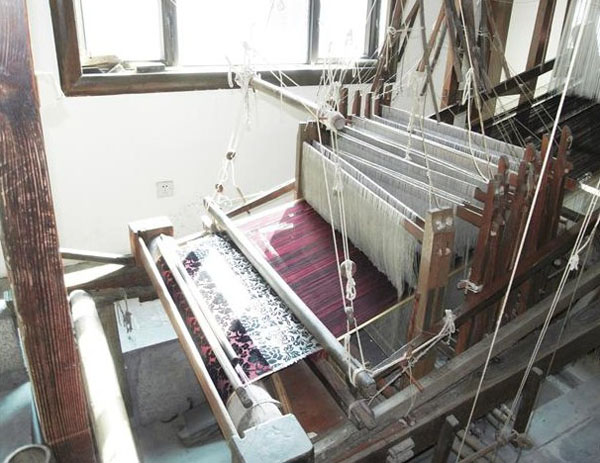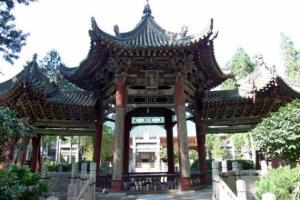Join-in Group Silk Road China Tours
About Us | Contact us | Tourist Map | Hotels | Feedback
Top Silk Road Museums in China

Overview:The Silk Road is of the most important long overland international trade route between the Middle East and China. Here are sereval top Chinese Silk Road or Silk Route museums and silk museums related to China Silk Road adventure.
The Silk Road is of the most important long overland international trade route between the Middle East and China. Here are sereval top Chinese Silk Road or Silk Route museums and silk museums related to China Silk Road adventure.
1. Silk Route Museum in Jiuquan, Gansu Province
The Silk Route Museum is located in Jiuquan, Gansu Province along the Silk Road, a trading route connecting Rome to China, traveled by Marco Polo. It is also built over the tomb of the Xiliang King in Gansu Province.
Founded by Mei Ping Wu and volunteers, the museum is a Institution devoted to the History and modern times of the Ancient Silk Road, to the fostering of an enhanced understanding between East and West. Opened in October 2009, The museum holds in trust for China and the world a rare collection of historic ancient Silk Road artifacts at its original time and splendid period.
Built on the site of the Xiliang King's Tomb, the museum covers an exhibition area of over 100,000 square feet and houses over 35,000 pieces from the Jade Road collection, a substantial subterranean art gallery, the Wei Jin Tombs, as well as historical sites from the Hexi Corridor of ancient China.
Exhibitions include displays of art, tools, and fossils covering the Jiuquan period, and the earliest evidence of central Asian civilization. In the Xiliang Hall, master pieces of jade work of Neolithic origin. A jade market open to local and outside traders, as well as, auctions and the Moon Light Cup of Jiuquan. The show pieces possess the characteristics from the pre-historical culture to Ming and Qing dynasties and represent the history, politics, economy, science and technology, cultural arts, husbandry production, religious belief and daily customs from thousands of years ago.
Anyone who has ever dreamed of experiencing the adventure of the ancient Silk Road must visit the Silk Road Museum in Jiuquan at the western end of the Great Wall at the fort of Jiayuquan. We have offices in California, Shanghai, and Gansu Province China with affiliations around the world.
2. Nanhai No. 1 Maritime Silk Road Museum in Yangjiang, Guangdong Province
The wreck of the Nanhai No 1 was found in the western part of the mouth of the Pearl River, the starting point of China's "Marine Silk Road". It did once connect China with the Middle East and Europe. It takes its name from 'Nanhai' - the South China Sea. The wreck is in exceptional condition. It is thought to contain 60,000 to 80,000 precious pieces of cargo, especially ceramics.
The wreck is currently still entirely covered by silt so that its location and shape had to be verified by sub-bottom profiler. It was recovered in an exceptional exploit – a bottomless steel container was placed over the wreck site. The lower part of the container was sharpened and it was driven into the seabed by placing heavy concrete weights on the container. The surrounding area was then dug out, the container closed from below with steel sheets and the whole raised.
The Nanhai No. 1 is exhibited at Hailing Island close to Yangjiang, a three-hour drive from Guangdong. The museum features an aquarium with the same water quality, temperature and environment as the spot in which the wreck was discovered. Archaeologists will now excavate the vessel inside the aquarium, thereby enabling visitors to observe underwater archaeological work in a museum environment.
The remains of the ancient vessel are expected to yield critical information on ancient Chinese ship building and navigation technologies. Its significance has been compared to the famous Chinese terracotta warriors discovered in Xian.The Nanhai No 1 museum is to become certainly one of the most important museums of underwater cultural heritage worldwide.
Opening hours: 9:30am – 5pm
Address: ten miles silver beach, Hailing Island, Yangjiang City, Guangdong Province, P.R.china
3. China National Silk Museum in Hangzhou, Zhejiang Province
CNSM (China National Silk Museum), near the West Lake in Hangzhou, is one of the first state-level museums in China and the largest silk museum in the world, covering an area of 50,000 square meters and a building area of 8,000 square meters. It was opened in February 26th, 1992, and welcomes visitors without charge since January 1st, 2004.
CNSM has renovated its permanent displays, which are “The Story of Chinese Silk” and “Sericulture and Silk Craftsmanship in China”, and open “Textile Conservation Gallery” and “Xinyou Archive Center”. As the largest specialized museum on textiles in China, the main gosl of CNSM is to research and conserve Chinese textile relics. Chinese Center for Textile Identification and Conservation was founded in 2000, and has carried out a large amount of research and practical activities in this field. In 2010, the center moved to CNSM.
As the largest center for textile collection, exhibition, conservation, research and education in China, CNSM is now the showcase of Chinese silk history and culture.
4. Suzhou Silk Museum in Jiangsu Province
Suzhou Silk Museum was proposed to build by the famous silk expert whose name is Qian Xiaoping, and was designed by the master builder Qi Kang. The style of the museum is elegant and it is famous for its culture trait and artistic quality. The exhibition hall can be divided into seven parts, the introductory hall, ancient hall, sericultural room, mulberry garden and farm house, weaving room, a street in Ming and Qing Dynasty and the central hall. The exhibitions consist of grosgrain, brocade, ghatpot, thin silk, velvet, gauze and so no. The silk fabrics contain dragon robe, embroidered robe, skirt, cheong-sam, kesi and embroidery. In the weaving room, wooden treading reel, Jacquard, kesi such ancient machines are displayed. Here, you can also enjoy the live weaving performance by using the ancient machines. In the museum, there are some places for people to enjoy, such as the sericultural room and mulberry garden. In the Ming and Qing dynasty street, prosperous silk market is simulated. All the exhibitions reflect the whole silk development history.
Silk is the symbol of the Chinese ancient civilization, it is extensive and profound. Chinese silk development history contributes to the Chinese civilization and makes an important impact on the world civilization. Since the museum opened to the audiences, it committed itself to the research of the traditional silk techniques and to save the precious silk relics. During the past 17 years, it has been reproduced and restored many typical silk relics, and part of the products won prizes. The “weaving technique of Song brocade “ has been listed in the Chinese Intangible Cultural Heritage in 2006. As the inherit department, Suzhou Silk Museum is bringing the research and protecting the silk into effect. Furthermore, it does its best to the culture communication with the foreign countries, such as Japan, Singapore, Thailand, England, France, Germany, Italy, Sweden, America, Canada and other area in China, such as Hongkong and Taiwan. In order to publicize the silk culture, it held and took part in exhibitions abroad for many times, and caused sensational effect.
Since the museum has been built, it became the base for Sochoo university, Suzhou patriotism education and Jiangsu science education. It plays a big role in organizing different kinds of activities to spread the silk culture and technology. Our museum obtained special attention from the leaders at home and abroad. For example, QiaoShi, Yao Yilin, PengChong, Fei Xiaotong, Li Tieying, Wen Jiabao, Wang Bingqian, Lei Jieqiong, Wu Xueqian, Wu Jieping, Gu Mu, Yang Rudai, Yang Chengwei, Lv Zhengcao, Wang Heshou, Zhou Erfu, Deng Nan, Wu Bangguo and so on.. Foreign guests are Minister of Singapore Li Guangyao and Vice Premier Wang Dingchang, former Secretary of the United States Dr. Henry Kissinger, former Minister of Canada Trudeau, former Premier of India Mrs Rajiv Gandhi, chairman of International Silk Association Adolf Forster, Vice President of Bolivia Cardenas, President of Iceland, vice chairman of UK-China Economic and Trade Commission and so on.


